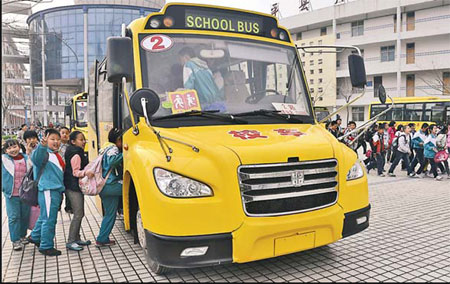New safety rules for school buses take effect
 0 Comment(s)
0 Comment(s) Print
Print E-mail China Daily, April 11, 2012
E-mail China Daily, April 11, 2012
China's long-awaited regulations on school bus safety finally came into force on Tuesday, including an extensive list of measures aimed at reducing the risk of tragedy.
Among the biggest changes is that buses carrying students will be given priority in traffic, while companies and drivers will need licenses to offer school transport services.
 |
|
Pupils of the Chiping County Experimental Elementary School in Liaocheng, Shandong province, board a bus after school on Tuesday. [China Daily] |
Yet, despite the landmark legislation being approved by the State Council, experts and industry insiders say there is still a long way to go before the changes will make a difference.
"The regulations do not mean the problem of school bus safety has been solved," said Zhou Hongyu, a National People's Congress deputy involved in drafting the legislation.
The professor of education at Central China Normal University stressed that further progress now relies on stringent enforcement by traffic police and local authorities, as well as funding.
Officials have spent more than four months fine-tuning the regulations, during which time the country has been rocked by several fatal crashes involving modified and often overcrowded school buses.
The latest accident occurred on Monday in Yangchun, Guangdong province, in which three kindergarten pupils were killed and 14 others injured.
Although the regulations will take effect immediately, schools and bus companies will be given a 90-day grace period to come up to scratch.
Rules and funding
In the new rules, a school bus is defined as a vehicle with more than seven seats that is transporting children receiving the State's nine-year compulsory education (ages 6 to 15) to or from school. This can be extended to preschoolers if a parent or guardian is unable to take them to or from kindergarten themselves.
Vehicles matching this description must now be given priority in traffic congestion, and other drivers are forbidden from overtaking them when students are boarding and disembarking.
School buses must also operate in routes mapped out by authorities to ensure safety, the regulations state.
Devising safe routes for school buses is key, Zhou said, adding: "There would still be potential dangers if there are safe buses but bad road conditions. The road conditions must be improved and operation routes must be devised soon."
Meanwhile, county-level governments and above have been made responsible for ensuring that elementary and junior-middle school students attend the closest school to their homes and that public transportation can provide a service for them.
If all those conditions cannot be met, authorities will be required to provide a school bus service.
Chu Zhaohui, a senior researcher at the National Institute of Education Sciences, believes the item in the regulation that rules that local authorities must provide school buses when no public transport is available, and schools are located far from children, is aimed at solving school bus problems in rural areas.
"The choice of location of schools must be combined with consideration of school buses," he said. "Sometimes a better solution would be to build a new school."
Central authorities say they will establish channels for funding school buses, with the funds shared by local and central authorities.
The regulation does not cover further details of how the funding will be allocated between the central and local governments, only mentioning that a specific method will be devised by the finance authorities of the State Council.
"The source of funding for the school buses has to be solved as quickly as possible," NPC Deputy Zhou said, "or local authorities will not take too much initiative, as some may worry that what they invest might later be covered by the central government."
Zhou said he proposed that the allocation of funding for school buses could be different for provinces in the eastern, central and western parts of China, depending on financial situations.





